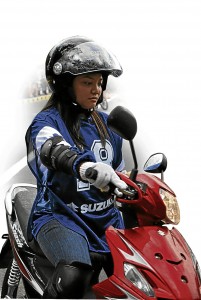Fuel prices pushing commuters to go on two wheels
Gentelle B. Castillo, 31, is not your typical commuter who relies on public transportation like the bus or jeepney. Neither does she drive or ride in a private car. This employee of Suzuki Philippines zips along at over 60 kph from her home in Caloocan City to her office in Pasig City even during rush hours. She can do this with relative ease because she now uses only two wheels instead of four or more.
For about a year now, Gentelle has been using her Suzuki Raider J Pro 110-cc motorcycle to and from work. She stopped using her Nissan Sentra sedan, which she estimated to have a fuel efficiency of about 12/km per liter, in favor of the motorbike, which yielded 60 km per liter.
She bought the bike without her family’s knowledge. Much as Gentelle loves the freedom and fuel economy the motorycle has brought into her commuting life, she also voices concerns that her family worries over her every time she goes to work and rides back home.
Unlike Gentelle, Love-love Tengsico Tioseco, 31, didn’t have to hide her two-wheeled intentions from her family. Her father, Bienvenido, was an avid motorcyclist, often traveling cross-country on his BMW R-50 and R-69-S. Mother, Dana, was a V-8 muscle car and Vespa scooter racer during her college days. Love-love once narrated to Inquirer Motoring that her parents eloped on a bike three times.
A biker since the 1990s, Love-love had even taken her motorbiking passions to a whole new competitive level in 2000 by becoming a super bike racer. More recently, she had also become an advocate for motorcycle safety. And characteristic, it seems, of most motorbikers, she also keeps close tabs of the fuel consumption of all her bikes (and cars, for that matter): She said she gets 6 to 8 km per liter on her two Mitsubishi Eclipses, 8 to 10 km on her Lancer, 18 to 20 km per liter on her 1000-cc sports bikes and 30 to 50 km per liter on her 2-stroke scooters.
All the road conditions today point to extremely happy times ahead for the motorcycle business. Cars don’t hold a candle to the cost effectiveness of motorcycles. The cheapest, most-fuel-efficient cars (say, an 800-cc Alto) can go for 34 km on a liter of unleaded. A 110-cc motorbike (say, a Suzuki GD110 at roughly a tenth of the retail price of an Alto) can go more than twice that, at 77 km at reasonable speeds. The maintenance cost of a motorbike is 5 to 10 times lower than that of a car. And speaking of man-hours lost by getting stuck in traffic, the motorcycle virtually makes this problem fly away, as well as all the hassles and unpredictabilities of riding in public conveyances. It’s really no surprise, then, that the number of motorbike riders in the country has zoomed up tenfold.
As of 2011, the number of registered motorcycles was 3,881,460, or 54.37 percent, of the total motor vehicles registered nationwide. In 2010, it was just over 3,482,149 million, or 52.48 percent of the total number of motor vehicles.
During a two-day Learn-to-Ride program at the Land Transportation Office that this writer participated in, engineer Joel Donato, chief of LTO NCR’s National Vehicle Inspection System, attributed the increased number of riders to the affordability of motorcycles, the hassles of city traffic, and rising fuel prices (P56 per liter on unleaded gasoline, rocketing up to P71 in some provinces) with no letup in sight.
In another interview, Arnel Doria, founder of the Safe T Ryders, gave his own take on the reason for the increased number of motorbike riders.
“Here’s how I look at the economics of motorcycles: If a person spends P100 a day for transport fare (on FX/jeepney/taxi/MRT), that would be P2,600 a month. Nowadays, motorbikes can be loaned at P2,000/month with downpayments as low as P5,000. So it’s cheaper to have your own bike. Owning a bike has other benefits: You control your own time and mobility, you have a transport on Sundays and holidays, and after having fully paid for it, you have property that you can sell to recover some of your payment.”
Doria added that “high gas prices will eventually lead to high transport fare. This will further drive the shift to motorcycle as an alternative economical mode of transport.”
With the increasing number of motorbikers, higher accident statistics are most likely to follow. But that shouldn’t necessarily be the case, if you ask Doria. “Road crashes are preventable and avoidable. With the proper frame of mind (being defensive as opposed to being aggressive), skill and confidence in the operation of a motorbike, and a little knowhow in maintenance, it is possible to mitigate the risks.”
Doria stressed that driver education is most imperative in these times when an increased number of pedestrians and motorists must share decreasing space on the roads and interact. “We should learn to give courtesy and respect for other road users’ rights and at the same time observe discipline.”
The World Health Organization has warned the deaths and injuries from motorcycle accidents have become a public health epidemic in many countries in Asia, including the Philippines.
Speeding, the non-use of helmets, risk-taking behavior, and drunk driving contribute to a significant portion of motorcycle accidents. The Metro Manila Development Authority’s Metro Manila Accident Reporting and Analysis System revealed that most of the 20,151 accidents it recorded from January to May in the last two years involved motorcycles.
Melencio Aquino, safety riding supervisor and Team Suzuki manager, stressed that motorcycle dealers should conduct safety seminars to educate all buyers. During the program, he demonstrated the basics of riding, including acquiring driver’s license, proper safety gears, basic control, handling, proper posture, and proper operation of motorcycle controls and functions.

